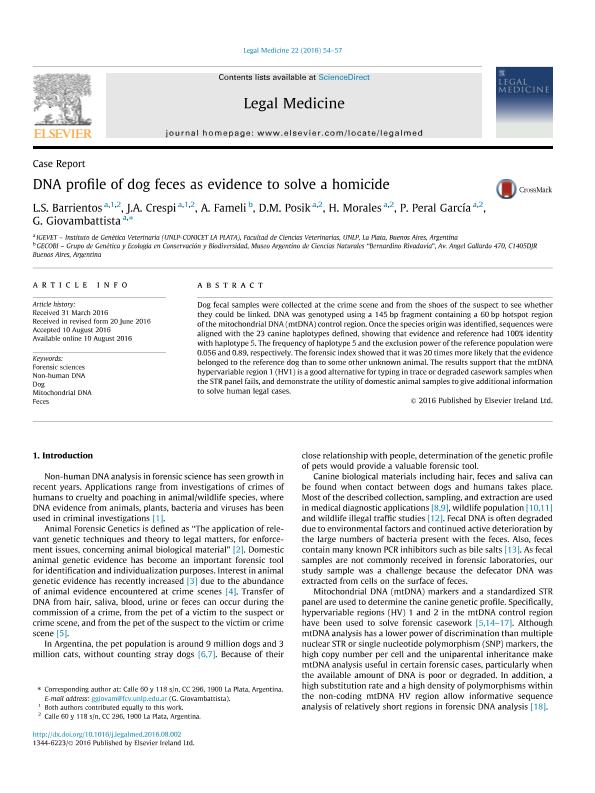Mostrar el registro sencillo del ítem
dc.contributor.author
Barrientos, Laura Soledad

dc.contributor.author
Crespi, Julian Alejandro

dc.contributor.author
Fameli, Alberto Francisco

dc.contributor.author
Posik, Diego Manuel

dc.contributor.author
Morales, Hernan Federico

dc.contributor.author
Peral Garcia, Pilar

dc.contributor.author
Giovambattista, Guillermo

dc.date.available
2018-06-11T17:31:36Z
dc.date.issued
2016-09
dc.identifier.citation
Barrientos, Laura Soledad; Crespi, Julian Alejandro; Fameli, Alberto Francisco; Posik, Diego Manuel; Morales, Hernan Federico; et al.; DNA profile of dog feces as evidence to solve a homicide; Elsevier; Legal Medicine; 22; 9-2016; 54-57
dc.identifier.issn
1344-6223
dc.identifier.uri
http://hdl.handle.net/11336/48095
dc.description.abstract
Dog fecal samples were collected at the crime scene and from the shoes of the suspectto see whether they could be linked. DNA was genotyped using a 145 bp fragmentcontaining a 60 bp hotspot region of the mitochondrial DNA (mtDNA) control region.Once the species origin was identified, sequences were aligned with the 23 caninehaplotypes defined, showing that evidence and reference had 100% identity withhaplotype 5. The frequency of haplotype 5 and the exclusion power of the referencepopulation were 0.056 and 0.89, respectively. The forensic index showed that it was 20times more likely that the evidence belonged to the reference dog than to some otherunknown animal. The results support that the mtDNA hypervariable region 1 (HV1) isa good alternative for typing in trace or degraded casework samples when the STRpanel fails, and demonstrate the utility of domestic animal samples to give additionalinformation to solve human legal cases.
dc.format
application/pdf
dc.language.iso
eng
dc.publisher
Elsevier

dc.rights
info:eu-repo/semantics/openAccess
dc.rights.uri
https://creativecommons.org/licenses/by-nc-sa/2.5/ar/
dc.subject
No-Human Dna
dc.subject
Dog
dc.subject
Dna Mitochondrial
dc.subject
Feces
dc.subject
Forensic Science
dc.subject.classification
Medicina Forense

dc.subject.classification
Otras Ciencias Médicas

dc.subject.classification
CIENCIAS MÉDICAS Y DE LA SALUD

dc.title
DNA profile of dog feces as evidence to solve a homicide
dc.type
info:eu-repo/semantics/article
dc.type
info:ar-repo/semantics/artículo
dc.type
info:eu-repo/semantics/publishedVersion
dc.date.updated
2018-06-11T14:29:13Z
dc.journal.volume
22
dc.journal.pagination
54-57
dc.journal.pais
Países Bajos

dc.journal.ciudad
Amsterdam
dc.description.fil
Fil: Barrientos, Laura Soledad. Consejo Nacional de Investigaciones Científicas y Técnicas. Centro Científico Tecnológico CONICET- La Plata. Instituto de Genética Veterinaria ; Argentina
dc.description.fil
Fil: Crespi, Julian Alejandro. Consejo Nacional de Investigaciones Científicas y Técnicas. Centro Científico Tecnológico CONICET- La Plata. Instituto de Genética Veterinaria ; Argentina
dc.description.fil
Fil: Fameli, Alberto Francisco. Consejo Nacional de Investigaciones Científicas y Técnicas. Oficina de Coordinación Administrativa Parque Centenario. Museo Argentino de Ciencias Naturales "Bernardino Rivadavia"; Argentina
dc.description.fil
Fil: Posik, Diego Manuel. Consejo Nacional de Investigaciones Científicas y Técnicas. Centro Científico Tecnológico CONICET- La Plata. Instituto de Genética Veterinaria ; Argentina
dc.description.fil
Fil: Morales, Hernan Federico. Consejo Nacional de Investigaciones Científicas y Técnicas. Centro Científico Tecnológico CONICET- La Plata. Instituto de Genética Veterinaria ; Argentina
dc.description.fil
Fil: Peral Garcia, Pilar. Consejo Nacional de Investigaciones Científicas y Técnicas. Centro Científico Tecnológico CONICET- La Plata. Instituto de Genética Veterinaria ; Argentina
dc.description.fil
Fil: Giovambattista, Guillermo. Consejo Nacional de Investigaciones Científicas y Técnicas. Centro Científico Tecnológico CONICET- La Plata. Instituto de Genética Veterinaria ; Argentina
dc.journal.title
Legal Medicine

dc.relation.alternativeid
info:eu-repo/semantics/altIdentifier/doi/https://doi.org/10.1016/j.legalmed.2016.08.002
dc.relation.alternativeid
info:eu-repo/semantics/altIdentifier/url/https://www.sciencedirect.com/science/article/pii/S1344622316300736
Archivos asociados
